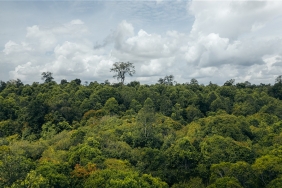COLLABORATION ON THE BORNEAN ELEPHANT SURVEY
At the end of January 2019, members of the Indonesian National Army (TNI) in the border region of North Kalimantan have assisted the Borneo Elephant Survey activities conducted by WWF Indonesia, the survey was conducted for one week. The TNI members came from the Military Rayon Command (Koramil) Sebuku Region, Nunukan Regency, North Kalimantan Province, as many as 2 people from Bintara Pembina Desa (Babinsa) named Tri Sugeng and Abdul Halik have helped the Borneo Elephant survey. Also involved in the survey were members of the Tulin Onsoi District Government, Borneo Nature Lovers Association (Gappeta), Cross Hiju Association (PLH), Elephant Conflict Task Force and the local community.
The involvement of the TNI in the elephant survey is the result of good coordination that has long been built by WWF Indonesia. When the request for support for elephant surveys was submitted, they welcomed and were ready to collaborate by involving their members. The involvement of TNI members in the elephant survey is certainly a form of concern for the parties in the effort to conserve elephants and their habitats.
This Borneo Elephant Survey is a continuation of previous surveys, started in February 2018 where previous surveys have also involved parties including the Nunukan Environmental Agency (DLH), the East Kalimantan Natural Resources Conservation Agency (BKSDA), Mulawarman University Forestry Faculty Students and Mapala 613 Nunukan Polytechnic. The survey is targeted to run for about 2 years from 2018 - 2019 using the occupancy method, the total survey area is around 100,000 Ha, so far the survey that has been done until February 2019 has been running around 70%.
The Borneo Elephant Survey itself is one of the programs contained in the Borneo Elephant Conservation Action Plan Strategy (SRAK-GK) 2018-2028 where data updates are needed regarding elephant populations and habitats in North Kalimantan until 2019. Previous data based on the last survey data in 2012, the elephant population in Kalimantan ranged from 30-80 individuals, the main habitat in Tulin Onsoi District which borders directly with the Sabah region, Malaysia. The elephant population in Sabah itself is much larger, estimated to reach 1,500-2,000 individuals. This survey activity is also supported by Toyota Motor Corporation and WWF Japan through the Living Asian Forest Project Joint program, which aims to encourage responsible forest management practices so that natural resources such as wood can become sustainable commodities.
The 5th stage of the elephant survey was divided into 3 survey teams, each team conducted surveys in the upper Sibuda River, the middle part of the Sibuda River and the upper reaches of the Apan River, the area is directly adjacent to the Sabah region, Malaysia. To reach the location had to struggle, the terrain was quite heavy, the team had to cross the river with a large giram and high cliffs. In the area, which reaches more than 100m above sea level, there are valleys and rivers used by elephants to move and find food, and there are also corridors that are strongly suspected to be elephant trails from Sabah, Malaysia to Nunukan, North Kalimantan or vice versa.
Abdul Halik and Tri Sugeng from Koramil are very happy to be able to help the Borneo Elephant survey activities, besides being able to monitor elephant habitat this activity can also monitor the security of forest areas in Tulin Onsoi District in preventing illegal logging, illegal logging used to occur in the 2000s, but now it is no longer there. We are ready to help the next elephant survey and do not hesitate to ask for our help, said Tri Sugeng when asked for his opinion after the survey. He added that TNI members in this case are very close to the community and other parties, hoping that with this survey activity our understanding will increase about Borneo elephants and then can provide education to the community for their conservation. They are regional assets, categorized as rare animals and protected by law, so let's work together to preserve them.
This week-long survey had several important findings including signs of elephant presence such as tracks, feces and elephant rubbing marks on tree trunks. In addition, it was found that the salt source area (sopon) in the upper reaches of the Sibuda River, about 1 km at the Sabah border, is included in the elephant corridor or track. Salt is highly favored by various types of mammals, especially elephants, salt sources are needed for mineral needs needed by elephants in breeding.
From the elephant survey until February 2019, the distribution of elephant habitat in Kalimantan began to be mapped, areas that have not been surveyed still have the potential for elephant presence and this will be done in the next survey. For the total population, of course, we will wait for the survey data to be finalized. After the survey is completed, the data will be very useful for decision-making basis for the implementation of elephant conservation in Kalimantan, both from the aspects of spatial planning, population management, habitat management and policy support from the government.





